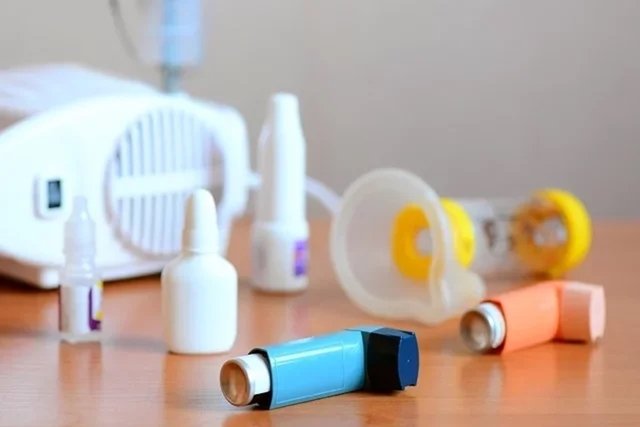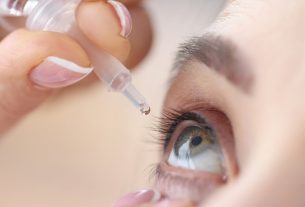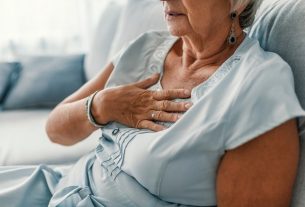Fluticasone is a corticosteroid indicated for the treatment of rhinitis, asthma, chronic obstructive pulmonary disease (COPD), atopic dermatitis or psoriasis, as it has a powerful anti-inflammatory action, which helps reduce irritation and inflammation of the lungs, nasal mucosa or skin .
This medicine can be found as fluticasone propionate or fluticasone furoate, in the form of an aerosol or “pump”, nasal spray, inhalation capsules, nebulizer vial or ointment.
Fluticasone can be purchased in pharmacies or drugstores, under the trade names Avamys, Flixotide, Lugano, Trelegy, Relvar, Plurair, Flutivate or Flixonase, for example, and should only be used under medical advice.

What is it for
Fluticasone is indicated for the treatment of:
- Seasonal or perennial allergic rhinitis;
- Mild, moderate or severe asthma;
- Chronic obstructive pulmonary disease (COPD);
- Atopic, contact or irritant dermatitis;
- Psoriasis.
Fluticasone has a powerful anti-inflammatory action, reducing inflammation in the lungs, nasal mucosa and skin, and should be used according to medical indications, as it has different presentations and forms of use.
How to use
The way to use fluticasone varies depending on its presentation and components of the medicine, which includes:
1. Fluticasona spray nasal
Fluticasone nasal spray is indicated to relieve the symptoms of allergic rhinitis in adults or children, and the medication should be applied inside the nostrils, preferably in the morning, as indicated by the otorhinolaryngologist.
The normally recommended doses are:
In the case of adults, once the symptoms of rhinitis are controlled, the otolaryngologist can reduce the doses to 1 spray in each nostril per day.
2. Fluticasone aerosol (pump)
Fluticasone in the form of an inhalation pump or inhalation capsules is indicated for the treatment of asthma or COPD, and must be used orally by placing the mouthpiece of the pump in the mouth and breathing deeply into the jet of medicine. See how to use the pump correctly.
The dosage of fluticasone pumps varies according to age, composition of the medicine and condition being treated and includes:
The use of inhaled fluticasone must be used with the advice of a pulmonologist, according to the condition being treated.
It is important that immediately after using the medication, the person brushes their teeth or rinses thoroughly with water and around the mouth with water, to avoid side effects.
3. Fluticasone for nebulization
Fluticasone propionate for nebulization is found in the form of vials (Flixotide Nebules) containing 0.25 mg/mL or 1 mg/mL in 2 mL vials, being indicated for the treatment of symptoms or exacerbation of asthma in adults or children with more than 4 years.
The normally recommended doses are:
- Adults and teenagers over 16 years old: 500 to 2000 mcg (1 vial of 0.25 mg/mL or 1 mg/mL), twice a day;
- Children aged 4 to 16: 1000 mcg (2 vials of 0.25 mg/mL or 1 vial of 1 mg/mL), twice a day.
Fluticasone for nebulization must be used by inhalation, using a jet nebulizer, as advised by the pulmonologist.
4. Fluticasone ointment
Fluticasone propionate ointment or dermatological cream 0.5 mg/g (Flutivate) is indicated for adults and children over 1 year of age for the treatment of dermatitis or psoriasis, and should be applied to the affected skin.
The normally recommended doses of fluticasone ointment are 1 application, 1 or 2 times a day, as advised by the dermatologist.
Fluticasone ointment should not be used for more than 4 weeks and improvement is usually seen 1 to 2 weeks after starting treatment.
Once the disease is controlled, the frequency of application must be reduced to the lowest effective dose, which will be determined by the doctor.
Possible side effects
Fluticasone in the form of a nasal spray can cause nosebleeds, headache, bad breath and unpleasant odor from the nose, runny nose and dryness and irritation of the throat or nasal mucosa.
Fluticasone for inhalation or nebulization can cause candidiasis in the mouth and throat, in addition to hoarseness. Furthermore, it can also cause increased blood sugar, sleep disturbances, hyperactivity and irritability, Cushing’s syndrome or growth retardation in children.
Fluticasone for inhalation can cause pneumonia or bronchitis in people suffering from COPD, with symptoms that must be reported to the doctor, such as fever, increase and change in the color of phlegm, increased coughing and/or difficulty breathing.
In the case of fluticasone ointment, local itching or burning may occur and prolonged use may cause thinning of the skin, stretch marks, increased hair growth and blemishes on the skin.
Although rare, fluticasone can also cause a serious allergic reaction, with symptoms such as swelling of the face, lips, mouth, tongue, or throat, or difficulty breathing. In these cases, you should go to the emergency room immediately. Learn how to identify the symptoms of anaphylaxis.
Who shouldn’t use
Fluticasone should not be used by children, pregnant or lactating women without first consulting a doctor.
Furthermore, this remedy should not be used by people who are allergic to fluticasone or any other component of the formula.
It is important to consult your doctor if you have or have recently had a respiratory tract infection, eye herpes or tuberculosis, or if you have diabetes, before using fluticasone.
Fluticasone ointment should also not be used by people with rosacea, infected wounds or ulcers, herpes simplex, chickenpox, acne or dermatosis in children under 1 year of age or juveniles.

Sign up for our newsletter and stay up to date with exclusive news
that can transform your routine!
Warning: Undefined array key "title" in /home/storelat/public_html/wp-content/plugins/link-whisper-premium/templates/frontend/related-posts.php on line 12
Warning: Undefined array key "title_tag" in /home/storelat/public_html/wp-content/plugins/link-whisper-premium/templates/frontend/related-posts.php on line 13



